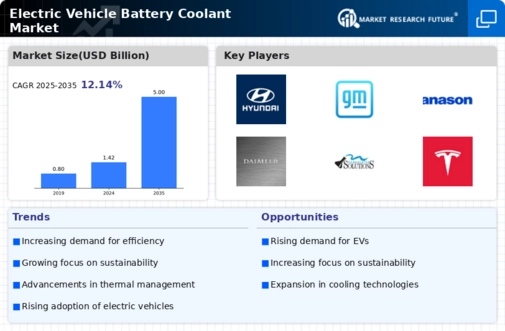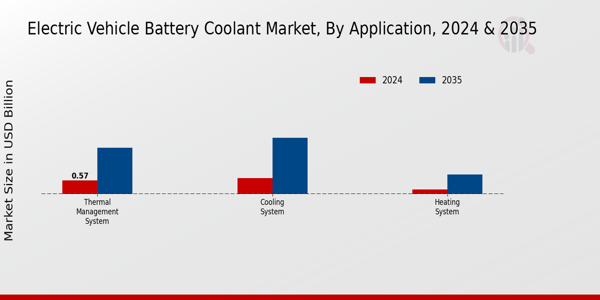Market Growth Projections
The Global Electric Vehicle Battery Coolant Market Industry is poised for substantial growth, with projections indicating a market size of 1.42 USD Billion in 2024 and a potential reach of 5 USD Billion by 2035. This growth trajectory suggests a compound annual growth rate of 12.12% from 2025 to 2035, reflecting the increasing importance of battery cooling solutions in the electric vehicle sector. The anticipated expansion underscores the critical role that battery coolants play in enhancing vehicle performance and safety, as well as their contribution to the overall sustainability of electric mobility.
Rising Demand for Electric Vehicles
The increasing global demand for electric vehicles is a primary driver for the Global Electric Vehicle Battery Coolant Market Industry. As consumers and governments alike prioritize sustainability and reduced emissions, the shift towards electric mobility accelerates. In 2024, the market is projected to reach 1.42 USD Billion, reflecting the growing adoption of electric vehicles. This trend is expected to continue, with projections indicating that by 2035, the market could expand to 5 USD Billion. The rising number of electric vehicles necessitates efficient thermal management solutions, thereby propelling the demand for specialized battery coolants.
Government Regulations and Incentives
Government regulations and incentives aimed at promoting electric vehicle adoption are pivotal for the Global Electric Vehicle Battery Coolant Market Industry. Many countries are implementing stringent emissions standards and offering tax credits for electric vehicle purchases. These initiatives encourage consumers to transition from traditional vehicles to electric alternatives, thereby increasing the demand for effective battery cooling solutions. As the regulatory landscape evolves, manufacturers are compelled to enhance their coolant offerings to comply with new standards. This regulatory push is expected to contribute significantly to the market's growth trajectory in the coming years.
Growing Awareness of Thermal Management
The growing awareness of the importance of thermal management in electric vehicles is driving the Global Electric Vehicle Battery Coolant Market Industry. Effective thermal management is crucial for maintaining battery efficiency, safety, and longevity. As consumers become more informed about the implications of battery temperature on vehicle performance, the demand for high-quality battery coolants is likely to rise. This trend is further supported by the increasing number of electric vehicle manufacturers emphasizing the role of thermal management in their designs. Consequently, the market for battery coolants is poised for substantial growth as awareness continues to expand.
Expansion of Electric Vehicle Infrastructure
The expansion of electric vehicle infrastructure, including charging stations and maintenance facilities, is a significant driver for the Global Electric Vehicle Battery Coolant Market Industry. As more charging stations become available, the convenience of owning electric vehicles increases, leading to higher adoption rates. This infrastructure development necessitates the use of advanced battery cooling solutions to ensure optimal performance during charging and operation. The synergy between infrastructure growth and battery coolant demand is expected to bolster the market, particularly as the industry anticipates a market size of 5 USD Billion by 2035.
Technological Advancements in Battery Cooling Solutions
Technological innovations in battery cooling solutions are significantly influencing the Global Electric Vehicle Battery Coolant Market Industry. Enhanced cooling technologies, such as advanced heat exchangers and phase change materials, improve battery performance and longevity. These advancements not only optimize thermal management but also contribute to the overall efficiency of electric vehicles. As manufacturers invest in research and development, the market is likely to witness a surge in innovative coolant formulations. This trend aligns with the projected compound annual growth rate of 12.12% from 2025 to 2035, indicating a robust future for battery coolant technologies.
























